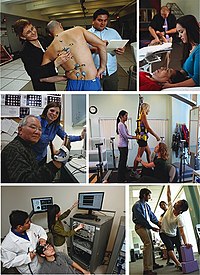
Photo from wikipedia
T he study by Gaikwad et al in this issue reports that younger adults with mild chronic motion sensitivity without known vestibular or central nervous system disorders who performed gaze… Click to show full abstract
T he study by Gaikwad et al in this issue reports that younger adults with mild chronic motion sensitivity without known vestibular or central nervous system disorders who performed gaze stabilization exercises had larger improvements in postural stability and motion sensitivity than those who performed saccadic exercises. Postural stability was measured with computerized dynamic posturography with immersion virtual reality (CDP-IVR), and motion sensitivity was measured by the motion sensitivity quotient (MSQ). Motion sensitivity is one sequela of vestibular-related disorders commonly treated by neurologic physical therapists in vestibular rehabilitation. A history of motion sickness may increase symptoms, and extend the length of recovery, in individuals with vestibular disorders1,2 and concussions.3 Motion sensitivity is a key diagnostic criterion of persistent postural perceptual disorder4 and is highly prevalent in individuals with vestibular migraines.5 Therefore, interventions that reduce impairments associated with motion sensitivity should be of interest to neurologic physical therapists. Individualized supervised exercise programs have been the standard for vestibular rehabilitation.1,6 Therapists use a problem-based approach in prescribing
Journal Title: Journal of Neurologic Physical Therapy
Year Published: 2018
Link to full text (if available)
Share on Social Media: Sign Up to like & get
recommendations!